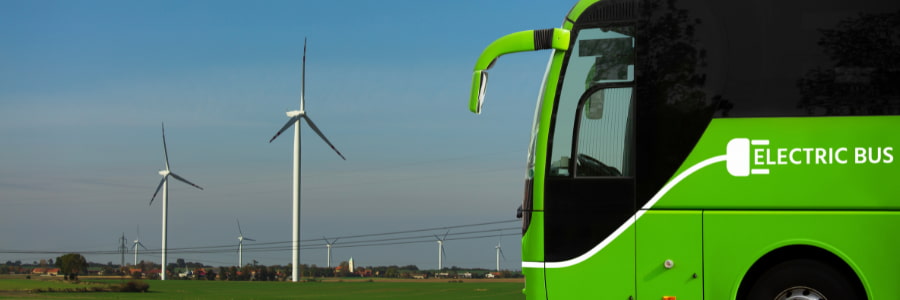A recent U.S. survey found that upfront costs are the biggest hurdle to fleet EV adoption.
The good news? EV prices are falling as new models emerge, while advanced smart charging solutions dramatically lower charging costs. Government and utility incentives and cheaper, more efficient batteries further reduce upfront costs. As a result, ROI on EV fleets is improving.
Looking ahead, the combination of EV fleet management and V2G (vehicle-to-grid) could unlock new revenue streams. VG2 allows EVs to draw and send energy to the grid, turning fleets into distributed energy resource (DER) assets. As a result, fleet operators can cut energy costs further and generate new revenue streams. According to a recent analysis by McKinsey, this could result in annual earnings of up to $16,000 per vehicle.
Fleet managers can prepare for V2G today by investing in compatible charging infrastructure and exploring utility options. Laying the groundwork now ensures a smoother transition – and maximizes future returns.

The revenue potential of vehicle-to-grid (V2G) varies widely based on location, fleet size, vehicle types, and use case. Utilities and independent service operators (ISOs) determine compensation rates, while V2G programs include backup capacity, rate optimization, and ancillary services. Fleet size, composition, and charging schedules also impact earnings.
McKinsey’s analysis found that heavy-duty and medium-duty trucks and school buses in Southern California Edison’s service area could generate $7,000 to $12,000 per vehicle annually through V2G. Larger battery capacities and fast-charging infrastructure maximize these earnings.
The value per EV differs drastically by region. A school bus in Georgia might earn only $1,000 to $2,000 annually, while the same vehicle in Virginia could make $15,000 to $16,000. Similarly, Australian studies suggest EVs could earn up to $12,000 per year providing frequency regulation services, with potential earnings varying by market and service type.

The financial potential of EV fleet management and V2G covers a range of services and opportunities. Many revolve around optimizing charging times or collaborating with utilities for V2G services.
Examples of services and solutions enabled by V2G and smart charging include:
Smart charging and peak demand: Fleets can cut electricity costs by shifting charging to off-peak hours. Advanced smart charging can automate charging schedules based on energy prices, vehicle needs, and grid conditions. Another option is participating in utilities’ demand response programs and managing charging programs.
Energy sales and transfer: Fleets can leverage V2G to charge when electricity is cheap and sell it at peak times. Alternatively, EVs can power buildings during high-cost periods, reducing overall energy expenses through peak shaving.
Frequency regulation: V2G allows fleets to provide grid balancing services, where EVs send or absorb energy in real time.

Adopting vehicle-to-grid (V2G) technology requires careful planning and a keen eye on maintaining operational efficiency. Fleet managers should consider several key factors connected with emerging V2G opportunities.
V2G earning potential depends on factors like battery capacity and charge power. Larger batteries enable greater energy discharge, which is crucial for energy arbitrage (selling energy back to the grid when prices are high). Charger power is essential for frequency regulation, where small amounts of energy are rapidly transferred to stabilize the grid.
Transitioning to an EV fleet involves upfront costs, so adding V2G capabilities requires a cost-benefit analysis to qualify investments in bidirectional chargers and faster DC charging to maximize revenue. Assessing potential earnings from V2G participation versus additional infrastructure costs should include considerations about dwell times—how long vehicles remain plugged in as longer connections during peak grid demand increase V2G revenue opportunities.

Fleet managers considering investing in V2G-ready equipment or vehicles can draw valuable insights from ongoing V2G projects worldwide. While the concept of using EV batteries to support the grid has been around for years, real-world applications are now proving its potential. Fermata Energy predicts that 10–20% of U.S. fleets will integrate V2G by 2027, and the market is expected to grow from $2.78 billion in 2021 to $20 billion by 2031.
One example is UK V2G trials that demonstrated significant cost savings with fleet EVs driving 10,000 miles annually able to save up to £840 per year while contributing toward lowering grid upgrade costs by £1.4 billion.
Transitioning to V2G can seem like a complex and costly endeavour, but new tools on the market are making it easier. Advanced smart charging solutions already allow fleet managers to optimize charging schedules, cut costs, and participate in managed charging programs today—all while laying the groundwork for future V2G integration.
Fleet managers can start by:
By following these steps and learning from existing case studies, fleet operators can prepare for a seamless V2G transition, maximizing both savings and revenue potential.